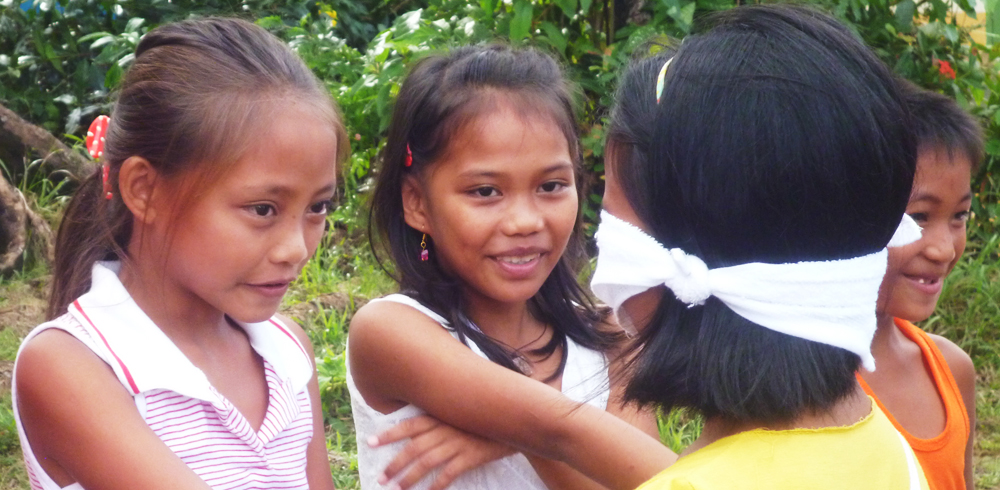
Main objectives | Find out more
Over recent years the Philippines network and Nepal network both played significant roles in the responses to natural disasters. These responses are by necessity more tailored to the situation. In order to reduce negative impact of natural disasters, Disaster Risk Reduction (DRR) programme is being carried out in the Philippines.
Over the last year our partner network in the Philippines, PCMN, has worked with local children and young people to conceptualize and develop Child-Friendly DRR Learning Modules. These modules are taught to children at mini-camps to help them understand different natural hazards and equip them with practical knowledge to protect themselves during disasters. Children are encouraged to share what they have learnt with caregivers to share the learning more widely.
The mini-camps include interactive activities led by youth facilitators who are volunteers from local network organizations, trained to conduct the DRR sessions. This enables peer-to-peer delivery of learning to build and strengthen the relationships between children and increase their capacities on disaster preparedness.
Our strategy can be broken down to meet three main objectives:
1. Equip 13,541 children between the ages of five to 14, in two cities and three municipalities for preparedness in Disaster Risk Reduction (DRR)
Mini-camps run during school holidays and cover four modules which describe four different disaster topics: Fire, Typhoon, Flashflood, and Earthquake. Each of the four modules have four stations:
- DRR Story Station: captures a brief DRR story with distinctive characters
- DRR Learning Station: provides additional inputs to the children to reinforce knowledge on the topic
- DRR Craft Station: crafts and artwork focused on key messages for children to remember
- DRR Action Station: interactive activities and games to teach children disaster preparedness
Each station ends with an action song (which has been written, performed and recorded by youth members of the pilot project team) to consolidate key messages in a child-friendly, creative and memorable way.
The children are divided into groups (of five to seven children ideally) assisted by youth facilitators as ‘crew leaders’ who will guide the children through the stations.
Up to 200 children can be reached in one mini-camp with 40 stations and 10 leaders, depending on the space that the community can provide. Bringing children together to learn increases connectivity to build a supportive community more capable of responding to disaster.
Children leave the mini-camp with a ‘survival kit’ to help them be safe during disasters. This includes: water, energy bar/protein snack or food that does not easily perish, small flashlight/headlamp, whistle, small first aid kit, hygiene kit, emergency blanket, medication or extra health-related items the child uses, hard candies for comfort and energy, comfort item (e.g. small stuffed toy), antibacterial lotion/hand sanitizer, photo album, wipes.
They are equipped for disaster prevention and know to prioritize preparation for safety in the event of disaster. Children will also be given resources to take to their parents with activities to share learning and discuss practical safety plans within families and small communities. This enables parents to support their children’s learning, benefit from the teaching themselves and prioritize the development of family DRR plans.
Because of its structure and the generic nature of the learning modules, this method can be used both in schools and in community settings through partnerships with local churches or faith-based organizations. We aim for wider scale rolling out of this project, ideally through the national curriculum, to reach even more children.
2. Develop core PCMN youth network leadership in areas of operation to be DRR community and camp leaders
The youth facilitators who run the mini-camps receive training to work as station and group leaders to facilitate youth-child training. As part of this, the youth facilitators develop a personal and/or family preparedness plan for themselves. PCMN has organized these youth volunteers into youth network chapters which have been registered via the National Youth Commission (NYC). These youth chapters are recognized by the local government which engages with them to address issues of child protection in the community. The chapter members receive training in child rights and are claiming these rights and advocating for them in their communities whilst training peers to understand these rights as well.
3. Expand network of collaborating organizations in the areas of operation to become DRR proficient and engage and facilitate the youth and child rights initiatives
After mapping local churches, NGOs, schools and community-based organizations for potential partnerships, the network produces a comprehensive report and directory of child protection agencies in the communities involved in the program to facilitate increased community engagement and stronger child protection. Greater collaboration strengthens community engagement with children on DRR as each organization is equipped to share knowledge with their communities.
We identify needs of the communities to shape tools and capacity-building training given to network members. This allows improvement in areas of identity, sustainability, systems, program management and results. We also train selected local leaders to be in-community adult advocates for DRR preparedness and mentors for youth who have received training to improve inter-generational collaboration in DRR creating inclusive plans.
We are working to further refine materials to be appropriate for younger children. We would also like to develop a management information system about children.
If you would like to find out more about our work is disaster preparedness, we would love to hear from you. Please contact us on (+44) 1865 811 660 or info@viva.org
